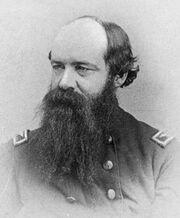| ||||||||||||||||||||||||||||||||||
James Chatham Duane (June 10, 1824 – December 8, 1897) was an engineering officer in the United States Army in the 19th century. He served during the American Civil War, then went on to command at Willets Point, New York, from 1866–1868. For ten years he constructed fortifications along the coasts of Maine and New Hampshire. He was president of the Board of Engineers from 1884-1886, was appointed Chief of Engineers in 1886, and retired in 1888 with the rank of brigadier general. He then became Commissioner of Croton Aqueduct in New York City. He published a paper on the "History of the Bridge Equipage in the United States Army." General Duane died in New York City.
James Chatham Duane in Southern Victory[]
James Duane[1] had a history in the US Army's engineer corps before the War of Secession began. During the war, Captain Duane organized the engineer equipage of General McClellan's army and commanded a battalion of engineers in 1862. Duane was attached to the headquarters of the Army of the Potomac during the disastrous Battle of Camp Hill, where he met George Armstrong Custer. After the war ended, Duane stayed on in the Army Corps of Engineers.
By 1881, Duane was a full Colonel. When the Second Mexican War began later that year, he was attached to the army of Brigadier General John Pope after the Utah Territory rebelled. His main task for the remainder of the war was restoring the infrastructure that had been damaged by the rebels.[2]
References[]
- ↑ While this character is only referred to as "John Duane", his description matches the historical James C. Duane.
- ↑ How Few Remain, pg. 135 Paperback.











